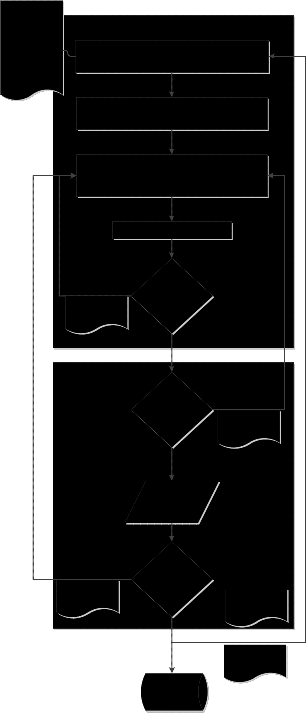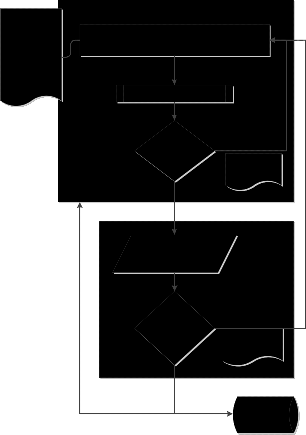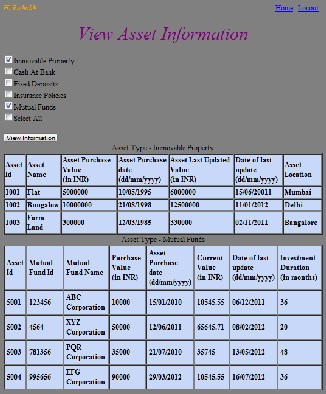
International Journal of Scientific & Engineering Research, Volume 3, Issue 10, October-2012 1
ISSN 2229-5518
JAVA-MySQL based Asset Management
System
Rishabh Gulati
Abstract— Dealing with enormous amount of information has become an integral part of complex systems across all sectors.This concept of efficient management of data when extended to the personal level can go a very long way in saving an individual’s time. In the current era, an individual owns a variety of assets ranging from monetary assets like Fixed Deposits, Bank Accounts to Immovable Assets like Land, Houses, etc. This paper delineates the concept of Asset Management using a JAVA-MySQL based system and also describes the various operations this system incorporates for managing the different assets efficiently.
Index Terms— Asset Management, Data Flow, Data Management, Java, JavaServer Page, JDBC Driver, MySQL
—————————— ——————————
he Asset Management System deals with the basic problem of managing enormous data. It caters to the organization of data in a well structured form facili-
tating its maintainance and expansion.
It makes use of the JAVA programming language to
process the data and MySQL database management sys-
tem for storing the data. This system uses a web-browser
for user interaction and provides the user the facility to add, modify and view asset information.
The JavaServer Pages are used for collecting, modifying and displaying information to the user. The system also incorporates user authentication leading to better data security.
Eclipse is an open source Integrated Development En- vironment (IDE) used extensively for web-application development. It has various versions like Callisto, Euro- pa, Ganymede, Galileo, Helios, Indigo and Juno. This sys- tem uses Eclipse for processing the information received via JavaServer Pages. It is also used for interacting with the database, in this case MySQL, for storing, modifying and retrieving information.
Apache Tomcat is an open source web server and servlet container. Tomcat implements the Java Servlet and the JavaServer Pages (JSP) specifications from Oracle Corporation, and provides a pure Java HTTP web serv- er environment for Java code to run. This would be used to host the JavaServer Pages required for user interaction.
MySQL is an open source database management sys-
tem. In this asset management system, MySQL is used for organizing the user information. The MySQL Workbench is used for creating and executing SQL queries. It also helps in designing and managing the database more effi- ciently.
It provides a console to gain better visibility into a database. Any further expansion or manipulation to the existing data structure can be achieved expeditiously us- ing MYSQL workbench.
A web browser is a software application for retrieving and presenting information on the World Wide Web. This system is hosted using the Apache Tomcat web server and can be accessed via a web browser by entering the URL of the hosted JavaServer Page. All the user-system interactions are done through the web browser.
When the user accesses the system using a web brows- er, he is presented with a login page. The user infor- mation is maintained in the MySQL database. On enter- ing the credentials, username and password, the user is authenticated with the values present in the MySQL da- tabase. After successful authentication, the user gets ac- cess to his personal asset management system. There are various operations which the user is presented with, namely,
1) Adding an asset.
2) Modifying an existing asset entry.
3) Viewing asset information.
The data flow and management with regards to the above three operations is detailed in succeeding sub- sections.
IJSER © 2012
International Journal of Scientific & Engineering Research, Volume 3, Issue 10, October-2012 2

ISSN 2229-5518
By selecting this option, the user is presented with a list of asset types. This list contains all the major asset types that can be possessed by an individual. A few of the asset types presented to the user are listed below –
1) Immovable asset (Property)
2) Cash At Bank (Savings)
3) Fixed Deposits
4) Mutual Funds
5) Insurance Policies
6) Appliances
7) Provident Fund
8) Miscellaneous
All the asset types provide certain input options to the user corresponding to that asset. On selection of an asset,
JavaServer Page
Drop-Down Menu to select type of asset
On selection of an asset – Present an input Form to the user corresponding to the type of asset selected
Form for accepting user inputs like Asset Name, Asset value, Asset Purchase Date, Asset Physical file reference
Form Submitted by the user
a corresponding form with several input fields like Asset Name, Asset Value, Asset Purchase date, Asset Physical file reference are presented to the user.
Upon form submission, several client side validations
are addressed for each input field for having consistency in data processing and storage. The user is intimated with appropriate error messages in case if a validation fails. After successful client-side validation the data received by the Java Beans, which are bound to the corresponding form input fields, is validated. In case the server-side val- idation is not successful, an appropriate message is dis- played back to the user giving information about the cause of the error.
After successful server-side validation, the connection
with MySQL database is established using MySQL JDBC (Java Database Connectivity) driver. For setting up this connection, there are three essential parameters required, namely, the MySQL-JDBC URL, the database Username and the database Password. Using these three parameters a connection is established with the MySQL database. If the connection fails to establish, an appropriate error message is displayed to the user.
Once the connection is established, the existing data structure information of the user is extracted. The data structure information maps the users with their associat- ed data tables. This information portrays the existing ta- bles for different types of assets for a particular user. If a table already exists for a particular asset for a particular user, the information is added to the table. In case it is the first entry of a particular asset type a new table is created
No
Appropriate Error Message shown to the user
No
Appropriate Error Message shown to the user
Client Side Input Field Validations Successful
Yes
Server Side Input Field Validations Successful
Yes
Data Extracted to be stored in the Database
Connection Establishing Process to MySQL Database successful
Yes
MySQL Database
No
Appropriate Error Message shown to the user
Appropriate Success Message displayed to the user
Data Stored in the database
and the asset information is updated. This table infor- mation is then appended to the user’s data structure in- formation for future use. After successful addition of the asset, the user is intimated about the same.
Figure1: adding an asset – Data Flow
Modifying an existing asset entry gives a user the flex- ibility to update his asset information. When the user se- lects this option, he is provided with a list of asset types in which there are existing entries. This list is extracted from the users existing data structure information, by
IJSER © 2012
International Journal of Scientific & Engineering Research, Volume 3, Issue 10, October-2012 3

ISSN 2229-5518
establishing a connection with MySQL database. Due to this, the user is presented with a drop-down menu with only those asset types which have a minimum of one as- set entry.
On choosing a particular asset type, all the entries for
that asset are staged to the user in the form of a list. The
user can then select an entry from the list for updation.
Upon selection of a particular entry, the input fields in
form for updation are embedded with the previous val-
ues which allow the user to update/modify only the de- sired field(s). When the user submits this form, it under-
goes the same cycle of events which take place while add- ing an asset.
In case the user wants to delete an existing entry, he can do so by selecting a particular entry and using the delete entry option. The user is prompted before the dele- tion transaction is initiated. Once the user’s consent is acknowledged by the system, a connection with MYSQL
This list is formulated based on the user’s existing assets. Only those asset types are indicated which have atleast one existing entry
JavaServer Page
Drop-Down Menu to select type of asset
On selection of an asset – Present all entries of the selected asset type
On selection of an entry – Present an input Form to the user with previous values of the entry embedded in the input fields
Form Submitted by the user
database is established and the particular entry is re- moved. After successful deletion of an entry the user is notified about same. The JavaServer Page is refreshed with an updated asset list.
This feature provides the facility of viewing asset in- formation for all or selected asset types. When the user selects this option, the user is presented with a list of asset types, extracted by using his data structure information. The user is provided with check-boxes alongside this list of asset types. Also, an option of Select All asset types is provided to the user in case there is more than one asset type available for viewing.
Upon submission of this form, validation with regards to the checkbox selection is performed. If the user submits the form without selecting any checkbox, he is intimated with regards to the same. In case one or more than one checkbox selection is made by the user, this information is processed to extract detailed information for the different entries of the selected asset types.
The connection to MySQL Database is established and the database is queried for detailed information of the selected asset types. The information with regards to the various entries in a particular asset type is collected in a list. The number of lists created equal the number of asset types selected by the user. These lists are then fed back to the JavaServer Page for viewing.
No
Appropriate Error Message shown to the user
No
Appropriate Error Message shown to the user
Client Side Input Field Validations Successful
Yes
Server Side Input Field Validations Successful
Yes
Data Extracted to be stored in the Database
Connection Establishing Process to MySQL Database successful
Yes
MySQL Database
No
Appropriate Error Message shown to the user
Appropriate Success Message displayed to the user
Data Stored in the database
Figure2: modifying an asset – Data Flow
IJSER © 2012
International Journal of Scientific & Engineering Research, Volume 3, Issue 10, October-2012 4

ISSN 2229-5518
This list is formulated based on the user’s existing assets. Only those asset types are indicated which have atleast one existing entry
JavaServer Page
List of asset types along with check boxes for selection
Form Submitted by the user
Client Side
The number of possible operations on the data can be increased. Features like sorting asset entries based on their value, last modified date, etc can be incorporated.
Computational features such as calculating the current
value of assets, calculating the increase or decrease in the value of an asset can also be integrated with the existing system.
A feature to create soft-copy in different file formats like .xls, .pdf, .doc, etc of different assets possessed by a
Validation
No. Of checkboxes selected >=1
Yes
Asset types required to be fetched from the database are identified
ConnectiYoens Establishing Process to MySQL Database successful
Yes
No
Appropriate Error Message shown to the user
No
Appropriate Error Message shown to the user
MySQL Database
user can also be unified in the system. This feature would
help the user to instantly process an electronic copy of the list of assets currently maintained in the system.
Figure3: viewing asset information – Data Flow
The asset management system is designed for efficient management of several assets possessed by an individual. It allows the user to add information about different as- sets in a quicker and systematic way. The data is organ- ised efficiently to aid future expansion of the system.
The user is facilitated with the feature of updating the existing information of an asset entry. This feature is es- pecially helpful while maintaining assets like Bank Ac- counts and Mutual funds, since their values are constant- ly changing.
As observed in figure4, the asset management system
provides the facility to view the different asset entries
pertaining to different asset types. This feature helps to
keep a track of all assets in a much quicker and efficient
way as compared to the traditional method of poring over
innumerable files.
Since, the system is organized in a very structured manner using MySQL database, it is possible to expand the system to encompass even more information. More number of attributes regarding an asset can be stored, modified and viewed depending upon the requirement.
Figure4: view asset information – JavaServer Page View
[1] Baron Schwartz, Peter Zaitsev, Vadim Tkachenko, Jeremy Zawodny, Arjen Lentz and Derek J. Balling, High Performance MySQL
[2] Mark Matthews, Jim Cole, Joseph D. Gradecki, MySQL and Java
Developer's Guide
[3] Budi Kurniawan, Java for the Web with Servlets, JSP, and EJB: A Developer's Guide to J2EE Solutions
[4] Deepak Alur, John Crupi, Dan Malks, Core J2EE Patterns: Best
Practices and Design Strategies (Second Edition)
[5] http://tomcat.apache.org/tomcat-7.0-doc/index.html
[6] http://dev.mysql.com/doc/workbench/en/index.html
IJSER © 2012